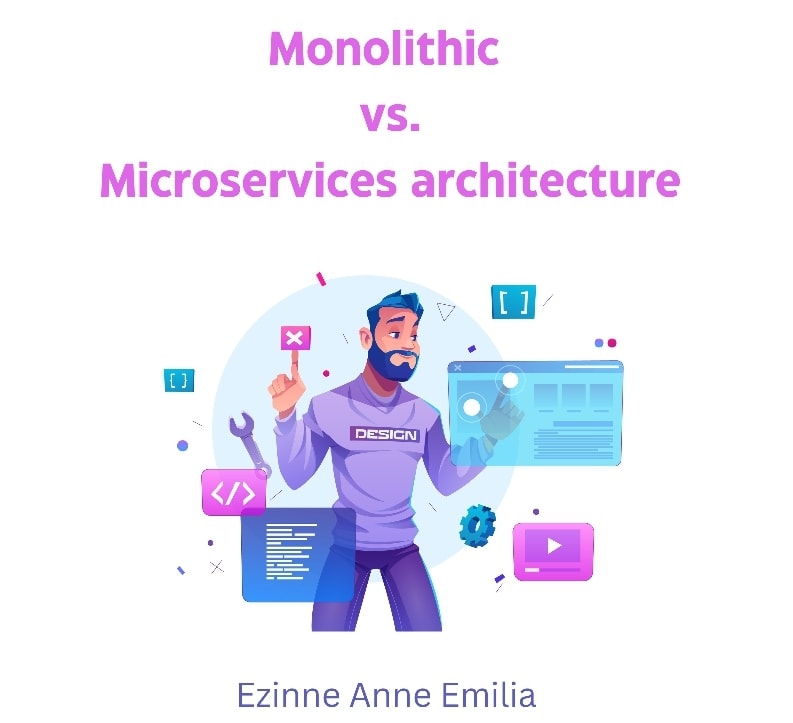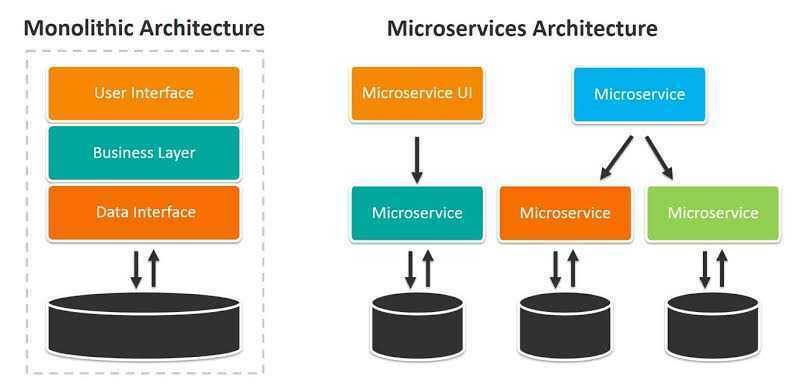Monolithic and microservices architectures are patterns you could use to build software applications. The major difference between both architectures is in their structure.
Monolithic architecture is the parts of a program that make up a unit.
On the other hand,
Microservices architecture comprises different services running independently.
In this article, you will learn:
- What is monolithic architecture?
- How it works
- What is microservices architecture?
- How it works
- Pros of monolithic architecture
- Cons of monolithic architecture
- Pros of microservices architecture
- Cons of microservices architecture
- Key points to note about monolithic and microservices architectures
What is monolithic architecture?
In plain English, when you say something is monolithic, it means it has a unit that is interwoven together, with large parts making up a single form.
Monolithic architecture in software development is a pattern of building a program as a unit. It has only one code base, which contains all the codes in a program.
Every part of the program is in the code base. Hence, refactoring code or even making minor updates is tedious and could break the entire application. Applications using this type of architecture could easily shut down when a developer makes an update containing a bug.
How it works
The monolithic architecture combines all the parts of the program into a single code base. These parts comprise features (packages) coined together. In a monolithic application, all the parts interact with a single database.
During updates, you could stop the system and afterwards deploy the entire stack. But this happens to applications that are big. New applications are relatively easier until they keep growing up to that point.
What is Microservices architecture?
Microservices architecture is a pattern of software development where software splits into separate services. They connect these services with APIs and operate independently from the code base.
Developers work in teams, and each team is in charge of a service. They can deploy their updates without affecting the code base or other microservices in the network. Microservices architecture is ideal for companies building large, complex applications.
How it works
In a microservices architecture, each service runs independently with its own memory space. APIs connect these services. The connection is in a light structure to allow each service to deploy and scale according to demand.
Microservices are small-sized and meant to handle certain operations. If any of them goes down, it will not have much effect on the entire system.
Also, teams work on each service, focusing on their specific areas without being overwhelmed.
Microservices architecture is a modern pattern in system design. Some startups begin with a monolithic design, and as the software grows, they move to microservices. However, there are fast-paced start-ups that start with microservices right away. This is a good decision, as refactoring monolithic applications to microservices is difficult. It would require skilled expertise, leading to higher costs.
Pros of monolithic architecture
Simplicity
Monolithic architecture has a simple design as it is a single structure. It is simple to code and run, especially when building a new application.
It is not overly complex like microservices, and it does not require complex processes for security.
Low cost of operations
Monolithic applications do not require extra funding for maintenance. A small team can manage the simple processes involved with little cost. There is no need for an excess workforce.
Easier testing
Their applications do not require complex tests. Because of their design, they have an easy mode of development. This applies to testing too; they involve simple series of tests, unlike microservices.
Cons of monolithic architecture
It is too rigid and does not have a flexible structure
Monolithic architecture does not support the use of different technologies. Making tweaks or changes to it would involve the entire application. This can cause it to shut down easily if there are harmful bugs.
Difficult updates
It does not have singular deployments. Because of the design, it cannot accommodate multiple deployments. It can also have slower build generation, making the deployment stage tedious.
Bugs in production
In monolithic architecture, bugs in production could affect the entire application. These bugs are usually noticeable even by users. If they are severe, it will cause the entire application to shut down.
Pros of microservices architecture
Easy to deploy updates
The microservices architecture has an easy mode of deployment. Companies using microservices can make up to 500 deployments in a day. This makes the applications fast and easier to implement changes regarding market trends.
Scalable
The applications are scalable. This means they can handle complex demands without slowing down when such applications have a large volume of demands to handle. They can attend to these requests quickly while maintaining their run time.
Reliable
This is another benefit of microservices. They are reliable as they can continue running even when there are bugs that could shut down the application. Because of the microservices nature of the applications, a particular service could be down if there are bugs in it, but the entire architecture would still be running.
Cons of microservices architecture
Making APIs compatible
Microservices require the use of APIs to connect the services. In most cases, using APIs that are compatible with these services could be an issue. Sometimes, developers would need to design new APIs for services since the APIs were not compatible with the service infrastructure.
Complex series of tests
Microservices require a long series of tests because of their complex structure. Each service would need to undergo all kinds of tests, including security ones, because of the potential security hazards it could cause.
Security vulnerabilities
Microservices use APIs, and these APIs could be a vulnerable point for hackers. Since APIs have always been an easy target for attackers, potential attacks could endanger the entire system. Hence, the need for optimal security in microservice systems.
Key points to note about monolithic and microservices
Monolithic architecture is ideal for small businesses building simple applications. As they have a single codebase, they do not require multiple resources. They have low-security concerns, unlike microservices.
Microservices are ideal for large, complex applications. APIs connect microservices, and these APIs could be a security concern. Hence, it requires security experts on the ground. It also requires teams across the board to work on a particular feature.
Both architectures are great for building, but microservices appear to be the full switch for companies.
Most of the companies that are using microservices architecture began with a monolithic architecture. As their business grew, they had to look for other options to contain their workload, which made them opt for microservices.
Netflix started with a monolithic structure and moved to microservices as their product grew into a large, complex structure.
Some companies use both architectures. For instance, appwrite uses both monolithic and microservices architectures.





Top comments (2)
Great write-up. Thanks for sharing
Thank you